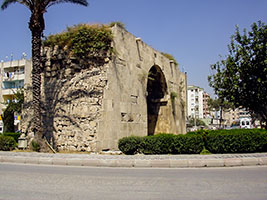Tarsus, the birthplace of St. Paul, is one of the oldest continuously inhabited cities in the world with a history reaching back to at least 3000 BCE. Surprisingly Tarsus has managed to keep the same name from antiquity to the present. Unfortunately, the ravages of war and time have destroyed most vestiges of the past. Moreover, since Tarsus was never abandoned the ancient city lies about 15-20 meters below the modern one. The modern city is mostly a sprawl of concrete apartment blocks.
Historical Background
Tarsus was once the meeting place of Mark Antony (Marcus Antonius) and Cleopatra, the legendary lovers. In 41 BCE, Mark Antony, while ruling the eastern part of the Roman Empire, had a residence here and had called Cleopatra to Tarsus in order to extract money from Egypt. Dressed like Aphrodite, the goddess of love, she arrived at Tarsus and seduced Marc Antony.
Tarsus was also an important east-west trading centre and had gathered a flourishing colony of Jews. At 10 CE, Saul of Tarsus, the later Apostle Paul (Paulus) was born here.
Sights & Photos of Tarsus
The bus drop-off point is near a Roman gate that carries the official name Cleopatra's Gate, but more commonly is called Gate of the Bitch, Kancık Kapısı. However, there is no known actual connection of the building with the Egyptian queen.
A well of Roman construction is said to stand on the site of Saint Paul's family home and is accordingly called Saint Paul's well (Sen Pol Kuyusu). Actually, the Byzantines or Crusaders, both of which were very inventive in creating relics and places of pilgrimage, probably named the well but there is no evidence that it had anything to do with St. Paul the Apostle. Despite that, Tarsus is an essential part of Christian heritage and one of the highlights of cultural Biblical Tours.
At the edge of the city, there are the waterfalls on the Nehri river (former Cydnus River), the Tarsus Şelalesi, which can be reached easily by dolmuş or taxi. The waterfalls surrounded by tea gardens and restaurants provide a cool and charming place for a drink or lunch.
In the waterfall park is also a statue that honours the 17th-century aşık poet Karacaoğlan who belonged to the Turkmen-Turks of the Tarsus mountains. From his poems, we learn that he made long travels abroad. His poems have elements like love, nature, and heroism. Playing on the saz or bağlama, the long-necked Turkish lute, it's said that he won many women's hearts. Karacaoğlan was also one of the first describing the passionate devotions between men and women.
https://www.turkeyphotoguide.com/tarsus?tmpl=component&print=1#sigProIdcabc0099f3
Travel Information & Travel Tips
Tarsus can easily be reached from Mersin. There are several buses and the ride takes only about half an hour.















